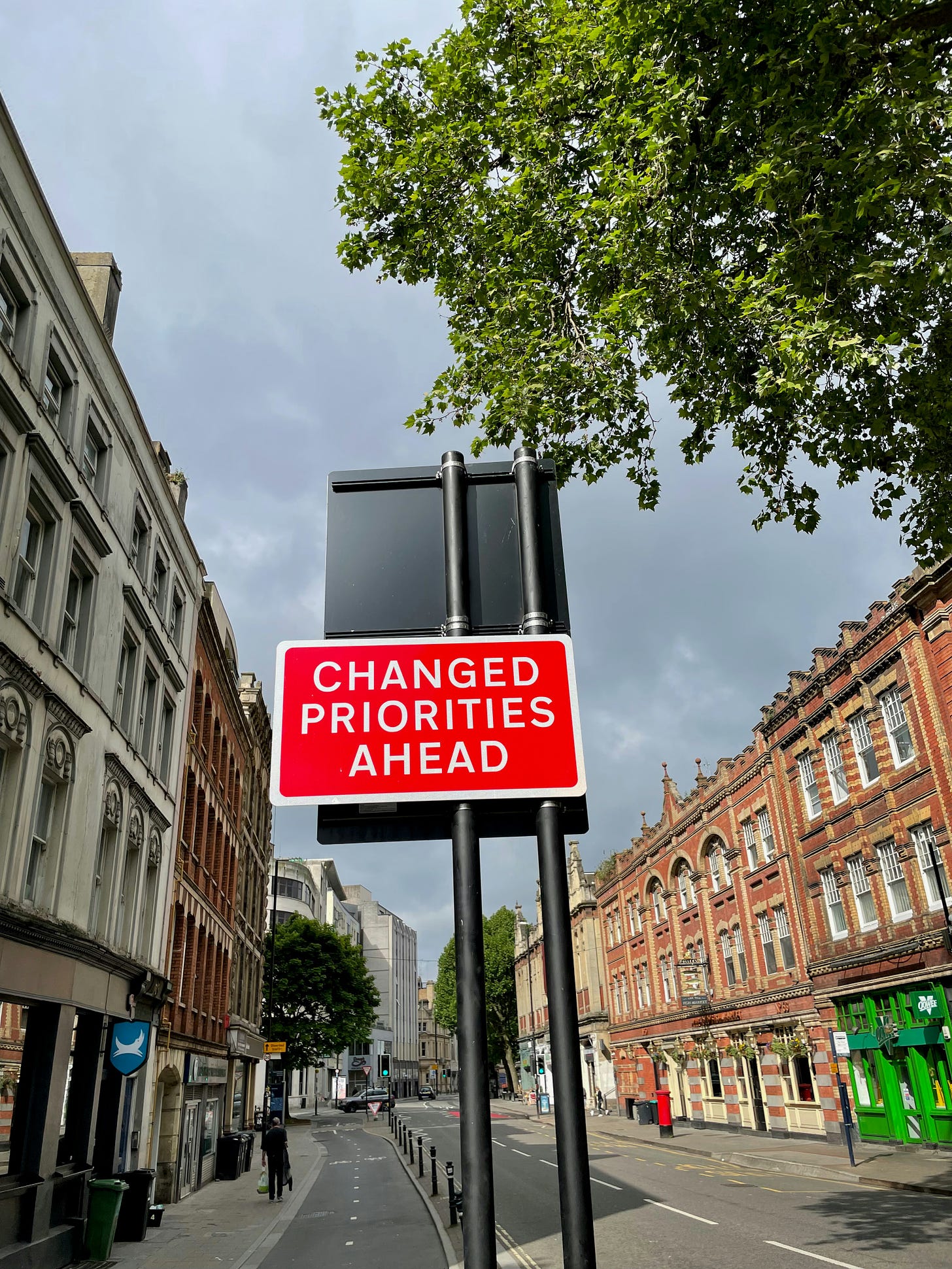Doing Everything = Doing Nothing
There is a fine line between handling our challenges and burning out.

When we encounter adversity, it’s natural to attack our challenges from many different angles, all at once.
We want to do anything to stop the pain and struggle, so we try to do everything, as if that will somehow solve our problem faster.
But spreading ourselves too thin has diminishing returns. When we fill our plate with new projects and action items, eager to pull ourselves out of the mire, we only end up sinking deeper.
I would know; I am dealing with this right now.
The hamster wheel
Lately, I’ve been working on building out new income streams beyond my newsletter. There are many different ways I can make an impact and use my experience to help others going through tough times. It’s exciting to think about all the different possibilities, but it’s a lot of work!
In the realm of challenges I’ve experienced in life, this is by far the most enjoyable, but it’s still an uncertain time. I really want to make this work.
The last few weeks have been intense. On a given day, you can find me hard at work on one of the following projects:
writing this newsletter
pursuing speaking opportunities
scoping out ebook ideas
researching best practices for becoming a resilience/life coach, and
writing a book on acceptance.
It’s rewarding work, but it’s a lot to manage. If Cal Newport knew my schedule, he’d rip his hair out.
The problem is, the more I do, the less effective I become. Progress slows. I know I should do less, but putting that advice into practice has been a challenge. The inner workaholic in me wants to do more and more when the solution is to do less and less.
That is, unless I want to be in the same place one year from now.
I’ve been here before
They say insanity is doing the same thing over and over and expecting a different result. I’m pretty sure they were talking about me.
Taking on multiple projects has never worked out for me. And yet, whenever I encounter a challenging time, it’s my go-to move. I respond to adversity by taking on the weight of the world…and I get crushed.
The most glaring example was when I was diagnosed with a muscle disease after college. I responded to this setback by attacking the disease in every conceivable way.
I tried new diets to minimize inflammation. I tested out low-impact exercise regimens. I emailed doctors who were experts in the neuromuscular field. I scoured research papers to better understand therapeutic approaches. I researched supplements. I pored over hundreds of posts on patient forums, looking for anything that might be a silver bullet.
Unfortunately, it wasn’t a silver bullet I found; it was burnout. I became so stressed out that I couldn’t function, and the stress made the symptoms worse.
I like to place field bets. I like to try ten different approaches simultaneously, in the hopes that one of them is the solution I’m looking for.
But I often forget that I’m not a stock portfolio. Placing field bets in real life is a one-way ticket to exhaustion, stress, and anxiety.
And yet, like clockwork, when the next challenge arises, I find myself falling into the same trap:
“I have a great idea - why don’t I try everything at once!”
🤦♂️
Five steps to lessen our workload
Focus is important in everyday moments, but it’s even more essential in how we respond to our challenges. If we want to effectively handle adversity, we need to take one step at a time.
This is a lesson I had to relearn last week. (In all honesty, I’m still re-learning it.) Here are the steps I took to lessen my workload and stave off burnout:
Step 1: Recognize that the current way isn’t working.
At some point, we have to face the music. It’s easy to justify the status quo, especially when we’re making tiny bits of progress addressing our challenges in multiple ways. But eventually, we’ll pay the price.
It takes courage to admit an approach isn’t working. If you’re struggling to change course and do less, know that you’re not alone. We are all prone to taking on too much.
It was a harsh truth to admit that I needed to reduce the scope of my workload. I was on a hamster wheel going faster and faster, with nothing to show for it.
It was time to change.
Step 2: Prioritize
When we’re facing a daunting challenge, we need to identify which tasks or projects will make the biggest difference — the big rocks we should focus on first that will have an outsized impact on our problem.
For example, if you’re going through a health challenge, maybe altering your diet will have the most impact. Or if you were let go of a job, maybe it’s learning a new skill or networking.
Problems crop up, however, when we equate busy work with progress. If we accomplish the wrong tasks and projects, we might end up making our problems worse.
There is a great quote from author and podcaster Tim Ferriss: “If you don’t prioritize, everything seems urgent and important.”
A little foresight can keep you from taking on too much at once.
Start by taking a few minutes to list out the different approaches you can take to respond to your challenge. Even if you can’t solve the problem outright, you can still take productive actions to improve your life.
Usually, one of the choices will stand out as the one to take. Start there. (If you’re not sure, choose one of the available options. Action is your friend.)
Going back to my example, I realized that the book is the project I should be working on. It can open many doors for me, and just as important, it’s what makes my heart leap with joy. This is what I need to focus on for the time being.
(The newsletter will continue on schedule, don’t worry.)
Step 3: Evaluate after a few weeks
One of the reasons we’re so scared to take one project at a time is that we’re afraid of the opportunity cost of saying no to the other options.
“What if B was the right move and not A? What have I done?”
This line of thinking can be especially tortuous when so much is at stake. If we try something and it doesn’t help us solve our challenge, we start to regret the decision we made. This makes us feel worse, which then makes us a less effective problem solver.
This fear can be neutralized by scheduling a self-check-in a few weeks after making the decision.
I like check-ins; they provide an opportunity for me to take stock of the progress I’ve made and revisit the options I turned down before. If I conclude that I’m on the wrong track, I can course correct and choose to do something else.
This won’t apply to every situation — since some decisions are irreversible — but most can be undone.
Going back to my example, I’ve committed to working on the book, but if I want to do something else a month from now, I can always pivot.
Step 4: Resist the temptation to second-guess yourself
Even after scheduling a self-check-in, the other options won’t go away quietly. As soon as you decide to focus on one approach, the alternatives will clamor for your attention.
I am terrible at making a decision and sticking to it. I choose a course of action and immediately have buyer’s remorse.
As soon as I chose to work on the book, I thought about the other projects I put on the back burner. They tempted me with their seductive siren song until I had an epiphany:
Not now doesn’t mean never.
I will get to the other projects in time. Just not right now.
Step 5: Ask for help
There will be instances when we have to try different approaches simultaneously, due to the urgency or the severity of the problem.
Rather than do everything ourselves, however, it’s important to reach out to others for help. This can be as simple as offloading tasks onto other people, asking for advice, or relying on a friend to brainstorm solutions.
As I figure out what projects to take on next, I’ve been reaching out to experts in my network to better understand my available options. These conversations have been enlightening.
If asking for help doesn’t come easy to you (and let’s be real, we all struggle with it), I wrote a two-part series on the topic last year.
Doing everything = doing nothing
When we’re going through tough times, there’s rarely a simple, straightforward solution that will make everything better. Adversity is complex.
When we’re struggling, the temptation is to do everything, but if we bite off more than we can chew — no matter how dedicated we are to fighting back — we will burn out.
Doing less will feel unnatural. The other projects and tasks will tempt you and make you second-guess your decision-making. But we aren’t meant to carry the weight of the world on our shoulders for any length of time.
The key is to build momentum. Accomplishing one project at a time gives us the motivation we need to continue on to the next task and endure in the face of adversity.
It is slow, steady progress, but it’s sustainable. Hopefully, I can heed my advice long enough to see this for myself.
I’ll let you know how it goes!
Related articles:
Slow is Smooth. Smooth is Fast.
What Really Matters in the End
Why It’s so Hard to Ask for Help
37 lessons for 37 - #33 is today’s topic!





Exactly what I needed to read today. Thank you, Chris. And isn't it funny how we keep needing to learn the same lessons again and again... I am there with you...
This is a great reminder to focus on one thing at a time. I especially like the idea of scheduling a check-in to avoid decision fatigue. Thanks for sharing!